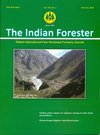Growth Performance of Swietenia macrophylla King and Azadirachta indica A. Juss. Seedlings Raised in Cocomoss Media and Different Packaging Conditions in Bangladesh
DOI:
https://doi.org/10.36808/if/2018/v144i2/122508Keywords:
Cocomoss, Swietenia macrophylla, Azadirachta indica, Packaging, Open Plastic Tray and Ventilated Paper Box.Abstract
Growth performance of Swietenia macrophylla and Azadirachta indica seedlings were studied in two containers (polybag and root trainers) with cocomoss media. Simultaneously seedling survival performance was studied in packaging condition with open plastic tray and ventilated paper box. S. macrophylla seedlings raised in polybag showed better performance in comparison to root trainers in terms of survival (87%), height (25.4cm), collar diameter (4.8 mm), biomass production-fresh wt. (6.3gm) and dry wt. (2.0gm) at the age of four months. The difference in height and biomass production was found statistically significant between the containers at 0.01>p level. A. indica seedlings also showed better performance in polybag over root trainers at the age of eight months. In polybag survival (100%), height (24.7 cm), collar diameter (6.5 mm), and biomass production - fresh wt. (10.1 gm) and dry wt. (3.5 gm) was recorded. No significance difference was found between the containers except dry weight at 0.05>p level. Both S. macrophylla and A. indica seedlings raised in polybag showed 100% survival in ventilated paper box, comparatively for longer period than root trainers at the age of eight months.References
Ahmed M.R. (2001). Institutional Constrains in development and conservation of forest resources in Bangladesh. J. Public Admin., 11:71-76.
BBS (Bangladesh Buruea of Statistics) (2014). Statistical Year Book of Bangladesh. Ministry of Planning. Government of the People's Republic of Bangladesh, Dhaka, xii+141pp.
BFD (Bangladesh Forest Department) (2012). Ministry of Environment and Forest, Government of People's Republic of Bangladesh Available at: www.bforest.gov.bd.
Brototi B. and Kaplay R.D. (2011). Azadirachta indica (Neem): It's Economic utility and chances of commercial planned plantation in Nanded District, Int. J. Pharma., 1(2):100-104.
Chowdhury Q.I. (1999). Bangladesh Country Overview. In: Bangladesh State of Environment Report 1999 (Q.I. Chowdhury eds.). Forum of Environmental Journalists of Bangladesh, Dhaka, 1-14pp..
Das D.K. and Alam M.K. (2001). Trees of Bangladesh. Bangladesh Forest Research Institute, Chittagong, 342pp.
David G.S. (2003). Method of packaging edible plants. http//w w w. free patents online.com /2003004163. html.
Davidson J. and Mazumder R.K. (1995). Root trainers in seedling production systems for forestry and agro forestry in Bangladesh. Manual for Nursery Technicians. Forest Department, Ministry of Environment and Forest. 51pp.
FMP (1993). Forestry Master Plan. Forestry Master Plan. Ministry of Environment and Forest, Government of the Peoples Republic of Bangladesh.UNDP/FAO/ BGD/88/025, Dhaka, 191 pp.
FSP (2000). Forestry Sector Project. First Five year Management Plan for Lawachara National Park. Vol, 2: Background and Support Material. Forest Department, Ministry of Environment and Forests, Dhaka, 221pp.
Ginwal H.S., Rawal R.S., Bandari A.S., Krishnan C. and Shukla P.K. (2002). Evaluation of potting mixtures for raising Dalbergia sissoo seedlings under root trainer systems. Indian Forester, 128(11): 523- 532.
Hawthorne W.D. (1990). Field Guide to the Forest Trees of Ghana. Chatham: Natural resources Institute of Overseas Development Administration, London, 278pp.
Imam H., Hussain A. and Ajij A. (2012). Neem (Azadirachta indica A. Juss) – A Nature's Drugstore: An overview. Inter. J. Biological Sciences, 1(6): 76-79.
Liegel L.H. and Venator C.R. (1987). A technical guide for forest nursery management of the Caribbean and Latin America. General Technical Report No 67. New Orleans, LA: USDA Forest Service. http// www dsworldbank.org/ Servlet /WDS content Server/ WdSP /IB.
Norman J. and Miller J.H. (1995). Organic and Compost- Based growing media for Tree Seedling (World Bank Technical Paper No 264. Forestry Series). The World Bank. Washington D.C. 47pp.
Opurni-Frimpong E., Karnosky D.F., Storer, A.J. and Cobbinah J.R. (2008b).Silvicultural System for Plantation Mahogany in Africa: Influences of Canopy Shade on Tree Growth and Pest Damage. Forest Ecology and Management. Special Issue; Sustainable Management of High Value Timber Species of the Meliaceae, 255:313-319.
Stamps R.H. and Evans M.R. (1999). Growth of Dracaena marginata and Spathi phyllum in Sphagnum Peat and Coconut Coir Dust- based Growing Media. http.//www. Aryaenterprises. com/2F coco moss 2html. 1-9pp.
Sundar D.S., Ananda S. and Karthick R.N.S. (2013). Antifungal activity of Swientenia mahogany on Candida albicans and Cryptococcus neoforman. J. Microbiology and Antimicrobials, 5(6): 55-59.
World Bank (1997). Review of key Environmental issues in Bangladesh, Workshop Discussion Draft (May 1997), World Bank, Dhaka, 22pp.
Downloads
Downloads
Published
How to Cite
Issue
Section
License
Unless otherwise stated, copyright or similar rights in all materials presented on the site, including graphical images, are owned by Indian Forester.





